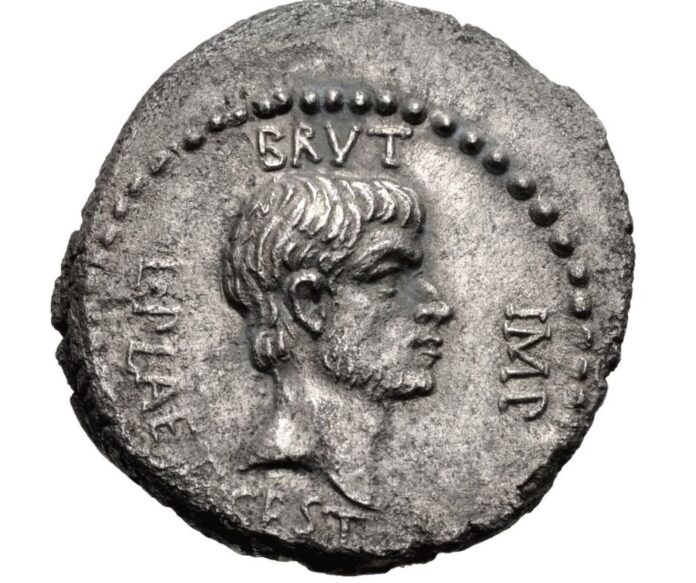
The Roman Republic and Roman Empire spanned the better part of 2,000 years and encompassed about 2.3 million square miles at their peak. The Romans had a tremendous influence on Western civilization and many aspects of their world survive to this day. Throughout their history, several leaders rose to lead their version of Rome to new heights. Each leader had unique coinage that would leave a small imprint of his/her legacy on the world. Let’s explore the lives of Julius Caesar, Marc Antony, Cleopatra, Augustus, Marcus Aurelius, and Justinian II to illustrate what impact they left on the Roman world and what beautiful coinage they left behind as part of their reign.
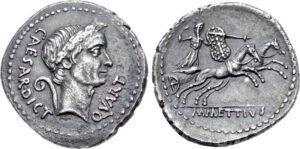
ALL IMAGES COURTESY OF CLASSICAL NUMIS-MATIC GROUP, LLC AT CNGCOINS.COM
Julius Caesar
During the end of the Roman Republic in the first century B.C., a social war occurred that caused the order of the old Republic to gradually crumble and decline. Over time, the elite oligarchs were replaced by warlords who opposed the Roman senate by the use of force. Their influence and reputation helped establish armies that would allow them to push for the top position within the government.
Among these warlords was Julius Caesar, a renowned general that enjoyed a successful military career that would lead to the formation of a Triumvirate leadership that included Pompey and Crassus.
The Triumvirate exerted control through the military over the entire Roman Republic with each leader receiving provinces under their jurisdiction.
After Crassus’ defeat and death during his invasion of Parthia in 53 B.C., Pompey and Caesar lost a powerful ally that would lead the two men into war for the supreme power of the Republic. While Caesar was completing his conquest of Gaul (modern-day France) in 51 B.C., Pompey was in Rome gaining favor with the Senate who were opposed to the increasing military authority of Caesar.
In 49 B.C., the senate would eventually demand that Caesar disband his army and gave Pompey authority to defend the Republic against Caesar.
Julius Caesar Making a Stand
Caesar refused and made his famous crossing of the Rubicon River along with his most trusted general Marc Antony in 49 B.C. to confront Pompey.
He was met with little resistance, as Pompey and many senators fled to Greece. Caesar would ultimately meet Pompey on the battlefield at Pharsalus in 48 B.C., where Caesar was outnumbered by more than 10,000 men. Despite the odds against him, the battle would end up being another example of Caesar’s supreme military tactics, as Pompey would suffer total defeat and flee for his life to Egypt where he was soon murdered. The Senate would declare Caesar as dictator several times, acknowledging his superiority on the battlefield and intense loyalty from his troops.
The coin seen above was issued at the beginning of 44 B.C., and displays Julius Caesar on the obverse with the Latin inscription “CAESAR DICT QVUART” which translated means “Caesar Dictator for the Fourth Time.” This was the first time a Roman leader appeared on their coinage, quite a statement at the time when the Roman Republic was ruled collectively by Consuls and the Senate. The reverse depicts the Roman goddess Juno Sospita, known as the Savior of Rome, a direct tribute to Caesar and his efforts to save the Republic.
This coin would prove to be controversial, as many felt that Caesar had acquired too much power.
Resentment had begun to build up as many traditional Republicans felt the title of dictator should only be a temporary title during a crisis.
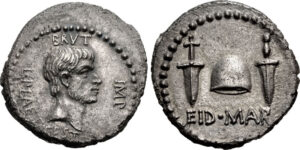
Brutus Denarius
Eventually, Caesar would be granted the title Dictator perpetuo (dictator for life) in 44 B.C. which created even more adversity. The tremendous authority bestowed upon one man was unprecedented and too much for many to handle.
It wouldn’t take long for a rebellion to take shape, which ultimately led to Caesar being murdered by Brutus and Cassius among other senators on the Ides (15th) of March. Ironically, Brutus later celebrated the event with a portrait of his own on the infamous “Eid Mar” coin referring to the ”Ides of March.” The coin seen on page 52 reveals Brutus on the obverse, while the reverse shows a liberty cap which was often referred to as a symbol of freedom. The cap is flanked by daggers, the weapon of choice by Brutus and his co-conspirators during their attack on Caesar.
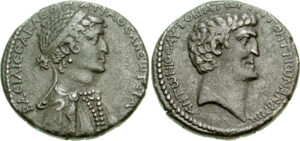
Antony & Cleopatra
In the aftermath of Caesar’s death, the senate would abolish his dictatorship to restore their authority. It would prove to be in vain, however, as two key figures emerged who would exert their authority over Rome.
Gaius Octavius (Octavian) was the great-nephew of Caesar and subsequent heir to most of his fortune. He was immediately at odds with Marc Antony, who was the most powerful ally of Caesar and felt the Republic should now fall under his control.
Antony would become a strong ally of and romantically involved with the Egyptian queen Cleopatra VII during this time. Tetradrachms, such as the one above from 36 B.C., depict Cleopatra on the obverse and Marc Antony on the reverse. It’s believed these coins declared the political alliance between the two and also served as payment to his soldiers during their eastern campaigns.
Antony exerted a lot of effort in bringing these provinces under his control, although Italy remained under Octavian’s influence. Open conflict seemed inevitable, and after a second Triumvirate failed involving the two men and Lepidus, the two armies eventually met at the Battle of Actium in 31 B.C. Octavian’s navy was led by Agrippa, a competent commander who routed Antony and Cleopatra’s navy and sent them both fleeing for Egypt. Antony and Cleopatra would eventually commit suicide there, leaving Octavian as the sole leader of the Roman world.
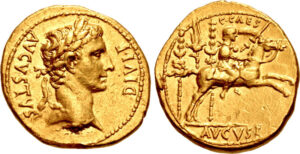
Augstus
This event marked the end of the Roman Republic, as Octavian had now achieved absolute power. He would continue to accumulate various titles and set out to methodically restructure the Roman Republic into a hereditary monarchy. It was the dawn of a new era, and the Roman Empire soon took shape. By 27 B.C., the Senate had bestowed upon him the honorific title Augustus, or the “Illustrious One.” The coin shown on page 53 reveals Augustus on the obverse facing right, with his heir Caius Ceasar on horseback with standards of the Roman army in the background.
Augustus would rule his newly established empire for 45 years until A.D. 14, providing the foundation of an Empire that would exist for many years to come.
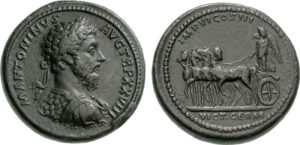
Marcus Aurelius
In the second century A.D., the Roman Empire reached its peak because of the diligence of its emperors and their ability to expand and defend their domain.
One famous Emperor during this period was Marcus Aurelius, who reigned from A.D. 161 to 180. During his 20-year reign, Aurelius witnessed large-scale wars that threatened the security of the Empire and its borders.
Aurelius was a stoic and according to historians, always performed his duty to the best of his ability. He is one of the few Emperors that personally led his troops into battle, despite his affinity for philosophy and a simpler way of life. The victories of his military campaigns are well documented on his coinage, such as this specially issued medallion struck in A.D. 173. The obverse of this coin shows Aurelius facing right dressed in military armor, while the reverse pays tribute to his recent victory over the Germanic Marcomanni and Quadi tribes.
Despite this military success, the gains that Aurelius experienced while defending the borders of the Empire were soon lost after his death in A.D. 180. His son, Commodus, proved to be relatively inept at military affairs and led to a steady decline in the Empire over the next 100 years. It wasn’t until A.D. 286 that Emperor Diocletian recognized the strain on the Empire and decided to divide it into an Eastern and Western Empire each governed by separate rulers.
The Empire was stabilized and entered its next evolution as two separate but connected territories.
The Western Empire would continue until it was overthrown by the Barbarian King Odoacer in A.D. 476, while the Eastern Empire existed well beyond but became better known as the Byzantine Empire.
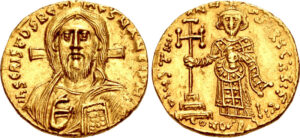
Justinian II
One influential Byzantine Emperor was Justinian II who ruled from A.D. 685 to 695 and also from 705 to 711. He was an ambitious Emperor who tried to regain the glory of the Empire with aggressive campaigns against the Arabs in Armenia and also the Balkans.
He’s known for social programs that supported lower-class citizens which was the primary source of his armies. He’s also famous for being the first Emperor to strike images of Jesus Christ on their coinage.
The gold solidus seen here depicts Christ Pantokrator (Almighty) on the obverse while the reverse reveals Justinian II holding a cross potent, known at the time as a strong Christian symbol. Justinian II was an ardent Orthodox Christian, making strong moves during his reign to reconcile the differences between the Eastern and Western Christian faith.
The Byzantine Empire would endure for another seven centuries after Justinian II until it eventually fell to the Ottoman Empire in A.D. 1453.
Impact of the Roman World
The Roman world had an enormous impact on Western civilization, including art and architecture. A study of Roman coinage reveals much about its people and leaders of that time. Rulers used the coinage to depict their favorite gods and to commemorate victories, exploiting coinage as the social media of the day.
These small works of art survive in abundance today, highly valued by collectors as miniature pieces of art packed with history and relevance.
This article about Roman imperial coinage previously appeared in COINage magazine. To subscribe click here. Story by Timothy M. Ryan.















